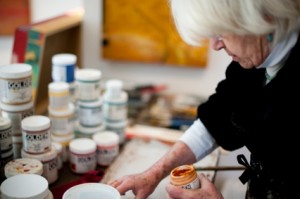Topography of Memory
Paintings by Marie-Louise Rouff
by Mette Qvistgaard | San Anselmo | February 2, 2006
 Over the years Marie-Louise Rouff’s concept of landscape painting has developed from direct observations and realism towards intuitive investigations and abstraction. From rendering the natural landscape of her native Luxembourg, Provence, and the hills of the Carmel Valley, she now focuses on exploring the emotional force of colors and lines based on fragments of memory. In 1995, Rouff was introduced to monotype printing and the energy, gesture, and spontaneity that characterizes this printing process became the catalyst for her shift. The monotypes became a perfect tool for exploring improvisation and the element of chance in this medium became central to her approach to painting.
Over the years Marie-Louise Rouff’s concept of landscape painting has developed from direct observations and realism towards intuitive investigations and abstraction. From rendering the natural landscape of her native Luxembourg, Provence, and the hills of the Carmel Valley, she now focuses on exploring the emotional force of colors and lines based on fragments of memory. In 1995, Rouff was introduced to monotype printing and the energy, gesture, and spontaneity that characterizes this printing process became the catalyst for her shift. The monotypes became a perfect tool for exploring improvisation and the element of chance in this medium became central to her approach to painting.
The surfaces of Rouff’s paintings are intricate and show energetic brushstrokes over layers upon layers of acrylic paint and paper collage. The tonalities are primarily warm and through the process of application and elimination, gradually layers of color and texture are building, creating depth and translucency. Atmospheric light emanates from the fields of color. At first the works can appear like pure lyrical abstractions, but recognizable elements – a tree trunk, the sun, the horizon line – emerge, creating a captivating push-pull effect between representation and abstraction within the compositions. The condensed representational elements are brought forward as remembered lines and visionary tracks that seem linked to an essential state of being in the world and refuse to be tied together by any one narrative.
 Rouff’s only guide and criteria for authenticity in creating these personal landscapes is her own emotional response. From her individual reservoir of sensory experiences sparked by remembered visual fragments, she creates a subjective topography. She draws the viewer into a world of emotional power and sometimes unsettling energy making the flux and elusiveness of memory visible. The nature that Marie-Louise Rouff depicts is defined by our human experience. This experience is always in the process of becoming. Just when we are aware of things, new possibilities emerge on the horizon and the past fades away as more ambiguous.
Rouff’s only guide and criteria for authenticity in creating these personal landscapes is her own emotional response. From her individual reservoir of sensory experiences sparked by remembered visual fragments, she creates a subjective topography. She draws the viewer into a world of emotional power and sometimes unsettling energy making the flux and elusiveness of memory visible. The nature that Marie-Louise Rouff depicts is defined by our human experience. This experience is always in the process of becoming. Just when we are aware of things, new possibilities emerge on the horizon and the past fades away as more ambiguous.
Mette Qvistgaard is an art historian and studied at University of Copenhagen and UC Berkeley. As a graduate student she worked at the Danish National Museum of Fine Arts, Statens Museum for Kunst. Mette has curated exhibitions for galleries and non-profit spaces and is the author of numerous articles on modern and contemporary American art for the Danish National Encyclopedia and exhibition catalogues.
Photo Credit: PhotogenicPecan Photography